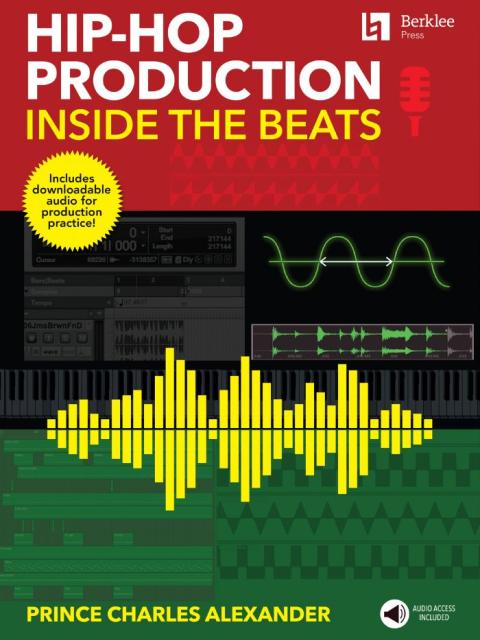From Turntables to Samplers, the Gear That Made Hip-Hop

Image by Omari Spears
This year marks the 50th anniversary of the birth of hip-hop. From one perspective, it’s a relatively short period of time. Consider how many of the genre’s founding legends—DJ Kool Herc, Kurtis Blow, MC Lyte, among countless others—are still regularly performing.
And yet, the amount of stylistic and technological innovation that has happened within these five quick decades of hip-hop is staggering, as a quick comparison between, say, Run DMC and Cardi B shows.

Image courtesy of Berklee Press
In his new book, Hip-Hop Production: Inside the Beats (Berklee Press 2023), Prince Charles Alexander, professor in the Music Production and Engineering Department, explores the interplay between creativity and new technology that helped hip-hop become a global juggernaut. As he explains in the introduction, the book “trace[s] a timeline that that includes commercially successful hip-hop records and the innovations they showcased.”
In the following list, guided by insights from Inside the Beats, we take a look at the initial technological advances that formed rap’s foundation. While hip-hop hasn’t stopped innovating and new gear will continue to shape the future of music, these five production elements, developed and first utilized in the genre’s early decades, are responsible for giving hip-hop its template.
Turntables: DJ Kool Herc (1973)
At a house party in 1973, DJ Kool Herc unknowingly sparked hip-hop’s flashpoint when he added a second turntable to his DJ rig. As Alexander says, “[I]f you had two turntables and a mixer, you could alternate a beat between the two turntables and extend a four-bar musical pattern—you know, that hot break section in the middle of that fly record—you could extend that musical pattern to infinity.” In the 50 years since, that party has only gotten bigger.
Given Herc’s main role as a live DJ, there are not many professional recordings of his early work. What we do have are a few grainy, lo-fi cassette recordings of some of those parties in the ‘70s. Despite the recording quality, these are still primary historical documents that give us a sampling of that initial energy and innovation. Take a listen:
Live Band: “Rapper’s Delight,” Sugarhill Gang (1979)
In the ‘70s though, turntablism could only take hip-hop so far. “Let’s face it, a young, Black DJ was not going to be playing turntables on American Bandstand in 1979, and you can only play for a limited number of people at block parties using turntables,” Alexander says.
Until the technology could keep up with hip-hop’s imagination, the fledgling genre used live-band instrumentation in order to help the music find a bigger audience. In 1979, “Rapper’s Delight” by the Sugarhill Gang did exactly that.
Drum Machine: “The Message,” Grandmaster Flash and the Furious Five (1981)
The emergence of the first drum machines—and hip-hop’s immediate adoption of the tech—came at the perfect moment. It bridged the gap between DJ culture and reaching wide enough audiences to create commercial potential. The first three—the Linn LM-1, Roland TR-808, and Oberheim DMX—gave rappers a way to program their own beats, setting the stage for sounds and rhythms that would, as Alexander says, “change the sound of hip-hop—and eventually, modern music in general.”
The drum machine also democratized hip-hop, opening the door for more and more rappers and producers, which in turn, expanded hip-hop’s creative and aesthetic ethos. “The Message,” by Grandmaster Flash and the Furious Five, uses the DMX, and is notable also for giving rappers a narrative outlet for social commentary. The genre created at a party now had a platform.
MIDI: “Push It,” Salt-N-Pepa (1987)
While MIDI (Musical Instrument Digital Interface) is not something that produces audio, it was a system, or musical language, that brought all the various music tech of the day together. “The MIDI protocol enables computers, synthesizers, controllers, sound modules, sound cards, samplers, and drum machines—from various manufacturers—to communicate with each other,” Alexander explains. “It is the revolution that changed music from a group endeavor to a one-person operation and is the life source of modern hip-hop production.”
While you can’t exactly hear MIDI, you can hear how it allowed artists to create more expansive productions and arrangements, as is the case for the iconic synth lines and quantized rhythms in “Push It,” by Salt-N-Pepa.
Samplers: “It Was a Good Day,” Ice Cube (1993)
Where to begin with samples. Simply defined, “A sample is an excerpt from a recording, which hip-hop producers often incorporate into new compositions, often via a device called a ‘sampler,’” Alexander says.
The use of samples has had a tortured legal history, but that hasn’t stopped it from becoming a nearly universal aspect of hip-hop, since it allows one to, as Alexander says, “sample any beat length and play it back with the simple push of a button. You could even layer in additional melodic, recorded performances.”
For an example of sample usage at this point, you just need to turn on a radio. To pick from the long list, consider how Ice Cube’s “It Was a Good Day” uses the drum beat and guitar riff from “Footprints in the Dark,” by the Isley Brothers (consider also how Ice Cube wasn’t even the first to sample this song, and he was far from the last).
